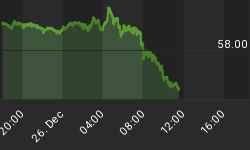With a slowing economy and over-supply concerns, crude oil dropped 30% from its February 2012 high to the recent low. An out of favor market often needs an external catalyst to attract the attention of investors. News out of Iran this week may provide a much-needed spark for oil and oil stocks. From the Wall Street Journal:
Crude-oil futures were higher Tuesday as some geopolitical risk has returned to the oil market, while hopes that central banks will take aggressive steps to boost their economies also pushed crude prices higher. Monday's news that Iran had drafted a bill to block the Strait of Hormuz for oil tankers triggered the return of some geopolitical risk, said Ole Hansen, head of commodity strategy at Saxo Bank. The front-month August contract on the New York Mercantile Exchange was trading up $1.38, or 1.7% at $85.13 per barrel.
MarketWatch added some insight into the possible impact of Iran's actions on black gold:
News that Iran launched drills Monday to test missiles that were capable of hitting targets as far away as Israel, according to a Wall Street Journal report, was in focus. An army general in the oil-exporting nation reportedly said the country wouldn't "sit idly" by as the U.S. and Europe built a missile-defense shield program that could target Iran. The drills came as U.S. and European embargoes on Iranian oil recently took effect. Citi Futures analyst Tim Evans said the Iranian rhetoric was "likely just bluster, but it is the kind of noise that has sparked price rallies in the past."
We recently re-entered the oil and commodity markets based on improving technicals and the opportunity to "buy low". The chart of oil below is as of the close on Thursday, June 28. A positive or bullish divergence occurs when price makes a new low and an indicator makes a higher low, which is indicative of slowing bearish momentum. A clear bullish divergence can be seen below by comparing the slope of the red line near point B to the slope of the green line near point A.

Taken in isolation a divergence is not a reason to enter a market. Buyers must show some interest allowing price to "confirm" the positive divergence. The chart below is as of Monday's close. On Friday, near point C, buyers showed strong interest in oil, producing a very attractive candlestick. Oil cleared its 20-day moving average last week and was able to hold above it during Monday's weakness, which increases the odds of short-term bullish outcomes. When a market is above its 20-day moving average, it tends to signal a bullish short-term trend.

If crude oil pushes higher, it may create a bullish bias for oil stocks as well. The table below shows the following oil stocks: Halliburton Company (HAL), Schlumberger Limited (SLB), National Oilwell Varco, Inc. (NOV), Baker Hughes Incorporated (BHI), Transocean Ltd. (RIG), SeaDrill Limited (SDRL), Weatherford International Ltd. (WFT), and a related ETF (OIH). The levels shown below can assist with risk management from a probabilistic perspective. You can think of column A as "resistance" and column B as a possible upside "target". Oil and oil stocks can be volatile, which makes risk management a must.

We described the positive divergence on the chart of crude oil above in detail. The charts that follow have similar, and potentially bullish, divergences on their daily charts. The Oil Services ETF contains all of the stocks in the table above, providing an alternative vehicle to gain exposure.

We would like to see the oil ETF, DBO, remain above its 20-day moving average. The bullish divergence has been in place for six weeks.

United States Oil Fund is similar to DBO and provides more liquidity. Since it is better positioned in some of our proprietary rankings, we like DBO slightly better than USO.

Halliburton provides various products and services to the energy industry for exploring, developing, and producing oil and natural gas worldwide.

Schlumberger supplies technology, integrated project management, and information solutions to the oil and gas exploration and production industries. Schlumberger has cleared its 20-day moving average (shown in blue).

National Oilwell Varco designs, constructs, manufactures, and sells systems, components, and products for oil and gas drilling and production, as well as provides oilfield services and supplies, and supply chain integration services to the upstream oil and gas industry. National Oilwell Varco remains in a downtrend and below its 20-day moving average.

Baker Hughes supplies oilfield services, products, and technology services and systems to the oil and natural gas industry. Baker Hughes cleared its mid-June high, which is a positive development.

Transocean provides offshore contract drilling services for oil and gas wells. From a trend perspective, Transocean would become healthier if it can exceed the mid-June closing high.

SeaDrill provides offshore drilling services to the oil and gas industry. Its services include drilling, completion, and maintenance of offshore wells; production drilling and well maintenance; and well services. SeaDrill does not have a textbook divergence, but it has established a textbook uptrend.

Weatherford International provides equipment and services used in the drilling, evaluation, completion, production, and intervention of oil and natural gas wells. Weatherford has been building a base for four weeks. A break above $13 would establish a short-term uptrend.

From a risk perspective, we remain concerned about long-term debt issues in Europe. Recent market sentiment readings tell us one more pullback may be needed in risk assets before a sustainable rally can begin. However, the positive developments over the past month have been significant enough to warrant the incremental buying we have done in recent weeks, including taking positions in oil and a basket of diversified commodities. We have been, and will continue to be bullish as long as the fundamentals and technicals alllow.
















